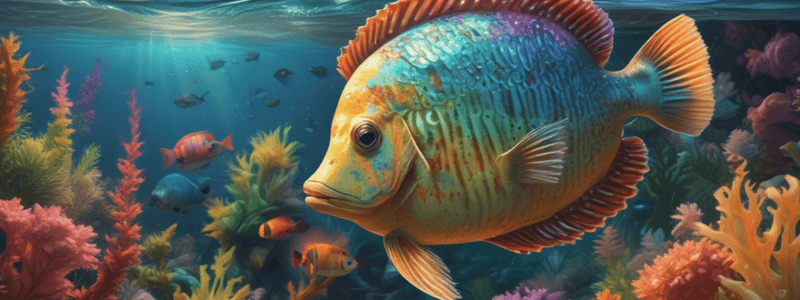Podcast
Questions and Answers
How do large animals differ from small animals in terms of their physiological processes?
How do large animals differ from small animals in terms of their physiological processes?
- Small animals are less susceptible to heat loss and desiccation.
- Small animals require more energy to support their larger bodies.
- Large animals have proportionally more mass and volume, affecting respiration and circulation. (correct)
- Large animals have a higher surface area-to-volume ratio, facilitating gas exchange.
What challenges do herbivores face in extracting nutrients from plant material?
What challenges do herbivores face in extracting nutrients from plant material?
- Plant material has a high protein content.
- Plant material is rich in fats and sugars.
- Plant material is structurally complex and contains cellulose. (correct)
- Plant material is easily digestible and lacks fiber.
What adaptations do carnivores have for obtaining nutrients from prey?
What adaptations do carnivores have for obtaining nutrients from prey?
- Efficient digestive systems to maximize nutrient extraction from animal protein and fat. (correct)
- Specialized digestive systems for processing plant material.
- Adaptations for photosynthesis to produce energy.
- Generalized feeding structures for extracting nutrients from diverse diets.
What distinguishes omnivores from herbivores and carnivores in terms of diet?
What distinguishes omnivores from herbivores and carnivores in terms of diet?
How does the surface area-to-volume ratio affect small animals?
How does the surface area-to-volume ratio affect small animals?
What is an example of a behavioral adaptation some species of scallops exhibit?
What is an example of a behavioral adaptation some species of scallops exhibit?
How do fish cope with environmental variation in oxygen levels?
How do fish cope with environmental variation in oxygen levels?
What is the primary purpose of gills in fish?
What is the primary purpose of gills in fish?
Which adaptation allows air-breathing fish like lungfish to supplement oxygen uptake from the water?
Which adaptation allows air-breathing fish like lungfish to supplement oxygen uptake from the water?
Why is maintaining oxygen balance critical for the survival of organisms?
Why is maintaining oxygen balance critical for the survival of organisms?
Which of the following is NOT a mechanism used by animals to regulate water balance?
Which of the following is NOT a mechanism used by animals to regulate water balance?
Endothermic animals maintain their body temperature primarily through which of the following processes?
Endothermic animals maintain their body temperature primarily through which of the following processes?
Which of the following strategies is used by some animals to conserve energy and water during periods of environmental stress or resource scarcity?
Which of the following strategies is used by some animals to conserve energy and water during periods of environmental stress or resource scarcity?
What is the primary function of homeostatic mechanisms in animals?
What is the primary function of homeostatic mechanisms in animals?
Which of the following statements about oxygen balance in animals is NOT true?
Which of the following statements about oxygen balance in animals is NOT true?
Which of the following is a strategy employed by some mammals to conserve energy and adapt to environmental challenges?
Which of the following is a strategy employed by some mammals to conserve energy and adapt to environmental challenges?
During hibernation, what happens to a mammal's body temperature and metabolic rate?
During hibernation, what happens to a mammal's body temperature and metabolic rate?
Which of the following is NOT a characteristic of aestivation in mammals?
Which of the following is NOT a characteristic of aestivation in mammals?
What is the primary purpose of adaptive responses like daily torpor, hibernation, and aestivation in mammals?
What is the primary purpose of adaptive responses like daily torpor, hibernation, and aestivation in mammals?
Which of the following statements about adaptive responses in mammals is FALSE?
Which of the following statements about adaptive responses in mammals is FALSE?
What is the primary function of the alveoli in the mammalian lungs?
What is the primary function of the alveoli in the mammalian lungs?
How do mammals living at high altitudes, such as the Tibetan yak or Andean condor, cope with low-oxygen environments?
How do mammals living at high altitudes, such as the Tibetan yak or Andean condor, cope with low-oxygen environments?
How do scallops, as marine bivalve mollusks, obtain oxygen from their environment?
How do scallops, as marine bivalve mollusks, obtain oxygen from their environment?
What is one physiological adaptation that scallops may exhibit in environments with low oxygen levels?
What is one physiological adaptation that scallops may exhibit in environments with low oxygen levels?
What is a key physiological challenge that both mammals and scallops face in their respective environments?
What is a key physiological challenge that both mammals and scallops face in their respective environments?
Which of the following statements accurately describes the thermoregulatory behavior of ectotherms during daily temperature fluctuations?
Which of the following statements accurately describes the thermoregulatory behavior of ectotherms during daily temperature fluctuations?
Which of the following best describes the phenomenon of aestivation in ectotherms?
Which of the following best describes the phenomenon of aestivation in ectotherms?
Which of the following statements accurately describes the adaptive responses of ectotherms to environmental challenges?
Which of the following statements accurately describes the adaptive responses of ectotherms to environmental challenges?
Which of the following statements accurately describes the relationship between body temperature and sprint speed in ectotherms?
Which of the following statements accurately describes the relationship between body temperature and sprint speed in ectotherms?
Which of the following statements accurately describes the thermoregulatory strategies of ectotherms in response to seasonal temperature changes?
Which of the following statements accurately describes the thermoregulatory strategies of ectotherms in response to seasonal temperature changes?
Which of the following is NOT a physiological adaptation that frogs use to maintain water balance?
Which of the following is NOT a physiological adaptation that frogs use to maintain water balance?
How do frogs address the challenge of water loss in terrestrial environments?
How do frogs address the challenge of water loss in terrestrial environments?
Which of the following is a key challenge related to osmotic regulation that marine organisms face in a saltwater environment?
Which of the following is a key challenge related to osmotic regulation that marine organisms face in a saltwater environment?
Which of the following is NOT a behavioral adaptation that frogs use to maintain water balance?
Which of the following is NOT a behavioral adaptation that frogs use to maintain water balance?
How do marine organisms address the challenge of maintaining a high internal salt concentration to match the external seawater environment?
How do marine organisms address the challenge of maintaining a high internal salt concentration to match the external seawater environment?
Which of the following is a key physiological adaptation that marine organisms use to prevent water loss in a saltwater environment?
Which of the following is a key physiological adaptation that marine organisms use to prevent water loss in a saltwater environment?
How do frogs address the challenge of water gain in aquatic environments?
How do frogs address the challenge of water gain in aquatic environments?
Which of the following is a key behavioral adaptation that marine organisms use to address the challenge of maintaining water balance in a saltwater environment?
Which of the following is a key behavioral adaptation that marine organisms use to address the challenge of maintaining water balance in a saltwater environment?
How do frogs use their renal system to regulate water and ion balance?
How do frogs use their renal system to regulate water and ion balance?
Flashcards are hidden until you start studying




